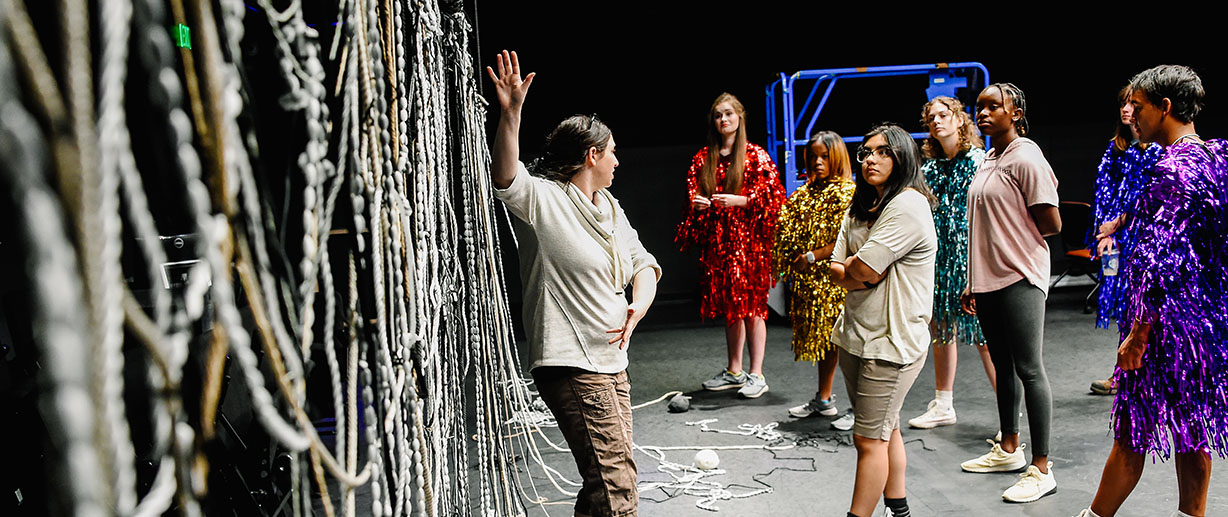By Robert W. Dalton
A lot of people dance around the issue of mental health.
Wofford professor Maya Michele Fein is leading a research project to build an entire production around the subject.
“The Tangle” will be performed at 2 p.m. and 7 p.m. Friday in the Sallenger Sisters Black Box Theatre. The 20-minute dance production is an expansion of the eight-minute version that debuted in 2021.
“Mental health issues are connected to us all in some way,” says Fein, assistant professor of theatre. “We want to destigmatize and bring awareness to the vast challenges of the human journey by bridging the arts and mental health education. Each experience with mental challenges is unique to the individual. By exploring this subject through dance, a language that transcends words, it allows for clear storytelling that also offers a personal interpretation.”
“The Tangle” is open to the public, but seating is extremely limited. Click HERE to request a ticket. Audience members will be required to wear masks.
Admission is free but donations will be accepted to benefit NAMI Spartanburg, which advocates for those living with mental illness.
Fein’s team consists of six current students, one incoming student and one recent graduate. It also includes Robin Levine – a New York City-based former Broadway performer who currently directs and choreographs nationally – as creator, writer, director and choreographer. The original score was created by award-winning NYC-based composer Jevares Myrick, who has performed on Broadway and in national tours.
The process started with a survey conducted by Fein, Chantel Aguirre ’23, a Chinese major from Spartanburg, and Kerrington Johnson ’23, a finance major from Anderson, South Carolina. The research contributed to the creation of the story, characters, dance movements and lobby display.
Aguirre says a common thread from the surveys returned was that respondents expressed concern about multiple mental health issues.
“Once we started to look across a wide variety of issues, we began to see similarities,” Aguirre says. “We want to point out those similarities and create a feeling of community and help people realize that they aren’t weird and shouldn’t be ostracized.”
Johnson says she wanted to be a part of the project because of her own experience.
“I didn’t really think a lot about mental health until I got here and had my own struggles,” she says. “People are showing a lot of vulnerability in the surveys. My favorite part is the positives in the lessons they learned in going through their situations.”
Messiah Moring ’25, a biology major from Boiling Springs, South Carolina, is the dance captain. Moring says she signed on because the project provided the opportunity to dance and to raise awareness about mental health.
“As a person who has struggled with depression and anxiety, I think it’s important to learn more about people like me and how they cope,” she says.
Audrey Buffington ’24, a theatre major from Greenville, South Carolina; Marc Rivera ’25 a chemistry major from Spartanburg; Anneka Brennon, an incoming first-year student from Spartanburg; and Joanna Burgess ’22, a physics and theatre major from Clinton, South Carolina, who also serves as the technical director, also are members of the dance team. Yasmin Lee ’23, a studio art major from Columbia, South Carolina, is creating a documentary on the evolution of the production and videoing the performance.
Levine says last year’s version looked at anxiety, depression and mood disorders. This year they included post-traumatic stress disorder (PTSD) and bipolar disorder, among others.
Rivera performs a dance that highlights one of the new additions. Several people had to hand sew dozens of mirror shards onto Rivera’s costume to represent his character’s journey.
“This person is broken but thinks he’s a star,” says Rivera. “Being a part of this project has shown me that many people have issues, and it’s taught me to be more aware of what others might be going through.”
Fein and Levine hope to expand the production again next year. Their goal is to eventually have a full-length production that they can take on tour.
“The next step is to continue the journey of the characters,” Levine says. “From here, there are a variety of mental health issues that we can dive into. The reason we are using the language of dance is that it is open to interpretation. People experiencing different disorders will experience them in different ways. We want people to see they are not alone.”
Buffington says helping people understand that they don’t have to struggle alone is what drew her to “The Tangle.”
“You can say things with your body that you can’t say with words,” she says. “To be able to say that I can feel you and I can understand you in a way that maybe no one has ever heard before can change someone’s life. That’s the best part about this project.”
